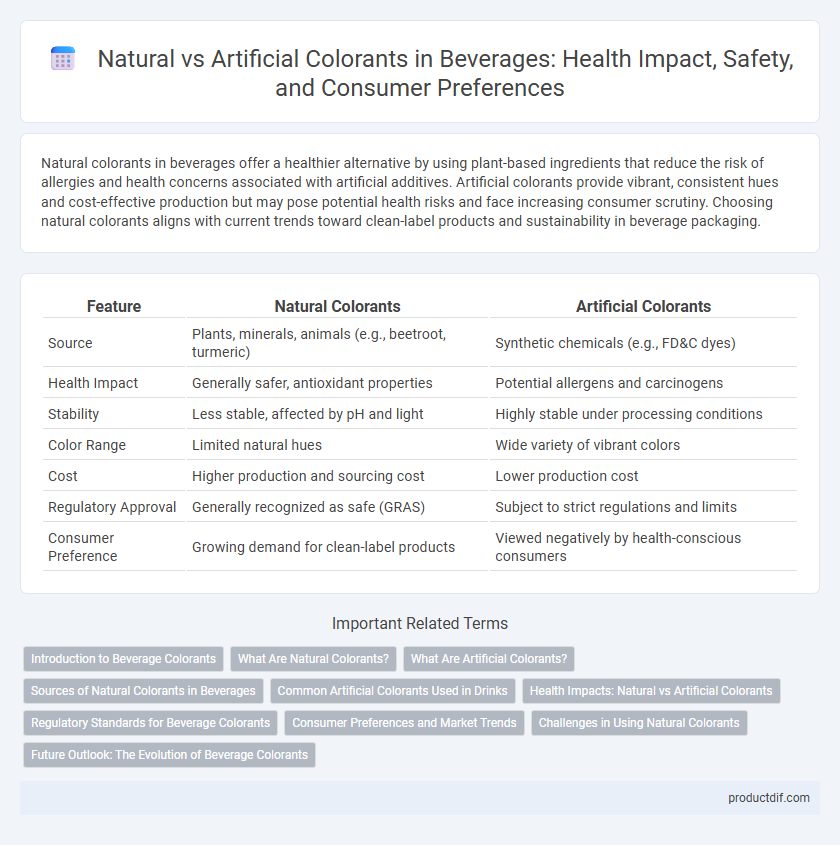Natural colorants in beverages offer a healthier alternative by using plant-based ingredients that reduce the risk of allergies and health concerns associated with artificial additives. Artificial colorants provide vibrant, consistent hues and cost-effective production but may pose potential health risks and face increasing consumer scrutiny. Choosing natural colorants aligns with current trends toward clean-label products and sustainability in beverage packaging.
Table of Comparison
| Feature | Natural Colorants | Artificial Colorants |
|---|---|---|
| Source | Plants, minerals, animals (e.g., beetroot, turmeric) | Synthetic chemicals (e.g., FD&C dyes) |
| Health Impact | Generally safer, antioxidant properties | Potential allergens and carcinogens |
| Stability | Less stable, affected by pH and light | Highly stable under processing conditions |
| Color Range | Limited natural hues | Wide variety of vibrant colors |
| Cost | Higher production and sourcing cost | Lower production cost |
| Regulatory Approval | Generally recognized as safe (GRAS) | Subject to strict regulations and limits |
| Consumer Preference | Growing demand for clean-label products | Viewed negatively by health-conscious consumers |
Introduction to Beverage Colorants
Natural colorants in beverages, derived from plant extracts, fruits, and vegetables, offer appealing health benefits and align with clean-label trends. Artificial colorants, synthesized chemically, provide vibrant, consistent hues and extended shelf stability but face scrutiny over potential health risks. Selecting between natural and artificial colorants depends on consumer preference, regulatory standards, and desired visual impact in beverage formulation.
What Are Natural Colorants?
Natural colorants in beverages are derived from plant sources such as fruits, vegetables, flowers, and spices, including beet juice, turmeric, and anthocyanins from berries. These pigments provide vibrant hues without synthetic chemicals and are often preferred for their perceived health benefits and environmental sustainability. Natural colorants contribute to clean labeling trends and align with consumer demand for organic and non-GMO ingredients in beverage formulation.
What Are Artificial Colorants?
Artificial colorants are synthetic dyes or pigments created through chemical processes to enhance or alter the appearance of beverages. These colorants offer vibrant, consistent hues and are often used for their stability and cost-effectiveness compared to natural alternatives. Common examples include tartrazine, sunset yellow, and brilliant blue, which are regulated by food safety authorities for permissible use levels.
Sources of Natural Colorants in Beverages
Natural colorants in beverages are primarily derived from plant-based sources such as fruits, vegetables, spices, and herbs, including beetroot, turmeric, annatto, and spirulina. These sources provide vibrant hues while offering antioxidant properties and potential health benefits, making them preferable for clean-label beverages. Extraction methods like cold-pressing and solvent extraction preserve the pigments' stability and intensity, ensuring consistent color quality in natural beverage formulations.
Common Artificial Colorants Used in Drinks
Common artificial colorants used in beverages include Red 40, Yellow 5, and Blue 1, which are synthetic dyes approved by regulatory agencies for food and drink coloring. These colorants offer vibrant, consistent hues and cost-effective production but have raised concerns regarding potential health effects and hyperactivity in children. Despite these issues, artificial colorants remain popular due to their stability and ability to withstand processing conditions such as heat and light exposure.
Health Impacts: Natural vs Artificial Colorants
Natural colorants derived from fruits, vegetables, and plants offer antioxidants and lower health risks compared to artificial colorants, which may contain synthetic chemicals linked to allergies and hyperactivity. Studies indicate that artificial colorants such as tartrazine and Allura Red can trigger adverse reactions in sensitive individuals, raising concerns about long-term exposure. Choosing beverages with natural colorants supports cleaner labeling and reduces potential health hazards associated with synthetic additives.
Regulatory Standards for Beverage Colorants
Regulatory standards for beverage colorants strictly differentiate between natural and artificial additives, with agencies like the FDA and EFSA imposing rigorous safety evaluations and approved usage limits. Natural colorants such as anthocyanins and chlorophyll are often favored due to their biocompatibility and consumer demand for clean-label products, yet they must still comply with purity and stability criteria. Artificial colorants, including synthetic dyes like FD&C Red No. 40 and Yellow No. 5, face stringent labeling requirements and acceptable daily intake regulations to mitigate potential health risks.
Consumer Preferences and Market Trends
Consumer preferences increasingly favor natural colorants in beverages due to growing health consciousness and demand for clean-label products, driving significant market growth in natural color solutions. Leading natural colorants include carotenoids, anthocyanins, and chlorophyll, which offer vibrant hues and antioxidant benefits compared to synthetic dyes like tartrazine and sunset yellow. Market trends indicate a steady shift towards plant-based, non-GMO, and allergen-free colorants, with beverages targeting millennials and Gen Z exhibiting the highest adoption rates.
Challenges in Using Natural Colorants
Natural colorants in beverages face challenges such as limited color stability under varying pH, light exposure, and temperature conditions, leading to color fading or alteration. Extraction and sourcing of consistent-quality natural pigments like anthocyanins, carotenoids, and betalains pose cost and availability constraints for large-scale production. Furthermore, natural colorants often have lower tinting strength and may interact with other ingredients, complicating formulation and shelf-life optimization.
Future Outlook: The Evolution of Beverage Colorants
The future of beverage colorants is shifting towards natural alternatives due to increasing consumer demand for clean-label ingredients and sustainability. Advances in bioengineering and extraction technologies are enhancing the stability and vibrancy of natural colorants, making them more viable for mass production. Market forecasts predict significant growth in natural colorant use, driven by regulatory support and improved cost-efficiency compared to artificial colorants.
Natural Colorants vs Artificial Colorants Infographic

 productdif.com
productdif.com